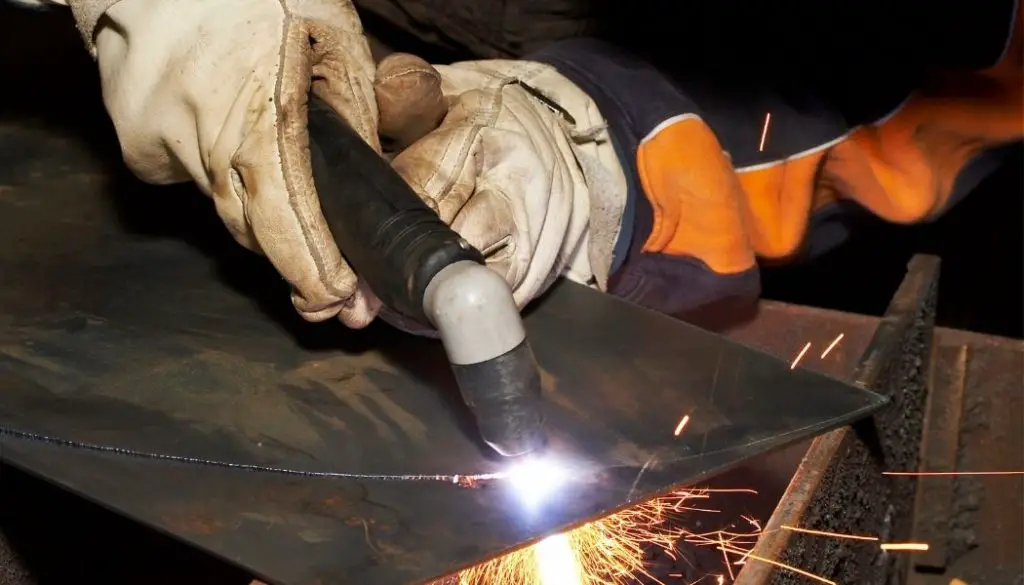A plasma cutter is one of the hottest tools you can ever use as a welder. It can get as hot as 40,000 to 45,000 °F.
You must follow some safety precautions to avoid eye or skin damage.
So how do plasma cutters get their heat, and how to deal with this incredibly high temperature? In this article, I’ll show you just that.
Table of Contents
What Is Plasma?
Plasma is one of the four matter stages, and it’s the one responsible for giving the cutter its extreme heat. But how does that happen?
The temperature of matter affects the distance between its particles. For instance, the distance between the particles is much tighter in the solid than in the liquid or gas forms of matter.
Plasma, on the other hand, goes the extra mile. It breaks through the electrons, separating them from the molecules. This creates an electrical force that puts the molecules together as one, thus creating plasma.
The plasma cutter uses this scorching heat of the plasma to cut through different metals effectively.

How to Handle the Heat?
Plasma cutters can get as hot as 40,000 or 45,000 °F (22,200 to 25,000 °C).
Let me give you an idea of how hot that is. The temperature on the surface of the sun is 9940 °F, which is almost a quarter of the plasma’s temperature!
Working with such extreme heat isn’t easy. Therefore, you need to follow some safety measures to avoid any hazards. Here’s a list of the hazards of using plasma cutters and the precautions you should follow:
Burns
When you use a plasma cutter, it generates sparks and heat to create the plasma arc. Therefore, you should ensure these sparks don’t contact your surroundings by having a spacious workplace. When the plasma arc cuts through metal, it drastically increases surface temperature.
This also means that while using the cutter, everything around you will be extra hot, including the nozzle, the torch, and the workplace in general. So don’t touch anything or allow anybody to get close to your workplace before the temperature goes down.
Fire Hazard
With sparks flying around you, using a plasma cutter can be a fire hazard, so ensure you wear protective flame-resistant clothes during operation.
In addition, you should make sure that you don’t have any lighters or matches in your pockets, as this can cause them to explode or catch fire.
Eye Protection
You need eye protection while dealing with bright plasma. For this matter, you should wear dark safety glasses with side shields.
In fact, the cutter’s flame is so bright that you should avoid looking directly at it. This flame is capable of causing permanent eye damage.
Hand and Foot Protection
With such a high temperature, you should protect your hands and feet. For this matter, you can wear leather gloves or welding gloves to protect your hands. However, wearing gloves doesn’t mean that you’re perfectly safe.
This intense heat of the plasma cutter’s flame can burn your skin even underneath the gloves. To avoid the risk of burns, don’t ever work with a plasma cutter bare feet.
Suspended Holder
Using plasma cutters isn’t an easy task. For instance, you shouldn’t leave your cutter on any surface as it can cut it accidentally.
Alternatively, you need to have a suspended container to keep the cutter. This avoids inflicting any damage on any surface that’s not intended to be cut.
Can You Modify the Temperature of a Plasma Cutter?
Fortunately, there’s a way to modify the temperature of your plasma cutter. All you need to do is adjust the temperature control on your plasma cutter.
Don’t worry about reduced effectiveness; plasma cutters are still effective even when not in full force.
Advantages
Plasma cutters aren’t your only option. Some people opt for laser or water cutters to reach almost the same results. Following is a short list of the advantages and disadvantages of using plasma cutters:
There are three main advantages to plasma cutters. They’re cheaper, faster, and handier than other types of cutters.
For starters, when it comes to price, plasma cutters win. They’re relatively cheaper than other options in the market. This makes them a better option in many cases.
In addition, plasma cutters are portable, making them more convenient to use. Another major advantage is that plasma cutters are much faster than other cutters.
Disadvantages
One of the significant downfalls of plasma cutters is that they leave unfinished metal corners as they cut through.
You won’t get this residue if you use laser or water cutters. Other cutters give cleaner cuts that need almost no finishing work.
Getting a plasma cutter may be cheap, but the cost of using it is significantly higher than other cutters.
This is because your cutter requires a great deal of electricity to generate plasma. To mitigate this problem, you should extinguish the plasma flame as soon as you finish.
What Metals Can You Cut with a Plasma Cutter?
Plasma cutters can work with pretty much any metal. However, it must be conductive. The most common types of metals that plasma cutters can cut through include:
Handheld plasma cutters can cut through mild steel up to 1.5 inches thick, while industrial models can go much thicker.
Conclusion
Plasma cutters get extremely hot, with a temperature that reaches between 40,000 and 45,000 °F. They can cut through any conductive metal, making them handy tools despite their hazards.
Before using a plasma cutter, ensure that you follow the safety measures to avoid hazards such as burns and even fires.

